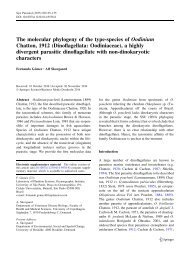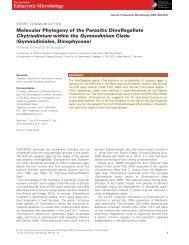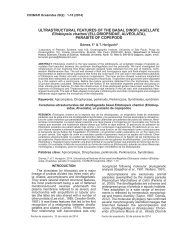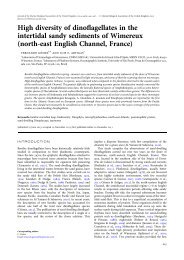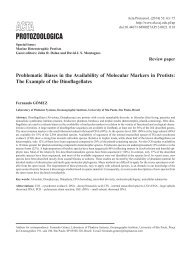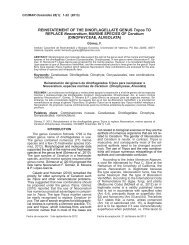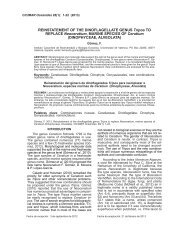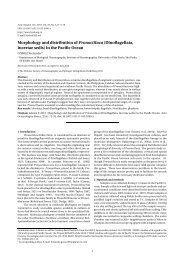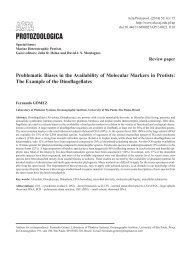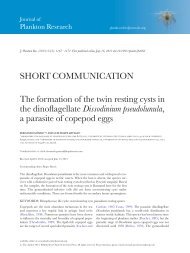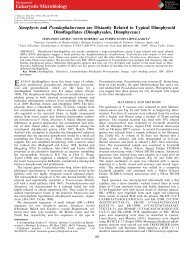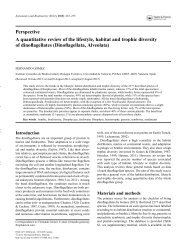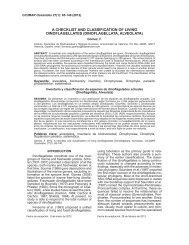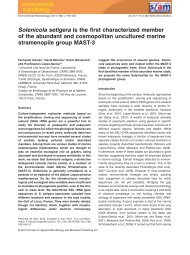THE DIATOMS Odontella sinensis, Coscinodiscus wailesii and Thalassiosira punctigera IN THE EUROPEAN ATLANTIC: RECENT INTRODUCTIONS OR OVERLOOKED IN THE PAST?
The diatoms Odontella sinensis, Coscinodiscus wailesii and Thalassiosira punctigera are the most common examples of non-indigenous phytoplankton species in the European Seas. We investigated their seasonal and interannual distributions at two fixed stations in the northeast English Channel (1998-2005). The climate conditions along our 8-y time series and those during the first historical outbreaks in Europe were reconstructed. Odontella sinensis was preferentially found in late summer and early autumn, especially after 2003. A change in the climate in 1903 may have favoured the development of O. sinensis that until then had gone unnoticed due to the low sample coverage. Coscinodiscus wailesii was preferentially found in winter and early spring, with a maximum in April 2001 (720 cells L-1). This coincided with exceptionally high precipitation rates, river discharges and a cold winter (negative phase of the North Atlantic Oscillation). Thalassiosira punctigera was sporadically found between autumn and early spring, with a peak in mid-December 2005 after abnormal autumn weather. The blooms of C. wailesii and T. punctigera in 1977-79 coincided with the arrival of the ‘Great Salinity Anomaly’ into the English Channel, negative NAO phase and higher river discharges. In addition to an introduction from sub-arctic waters, these two diatom species may remain as residual populations under ‘normal’ hydroclimatic conditions, misidentified, overlooked in the past and favoured after atypical climate periods. The consideration for these diatoms being labelled as introduced or non-native species is questionable.
The diatoms Odontella sinensis, Coscinodiscus wailesii
and Thalassiosira punctigera are the most common
examples of non-indigenous phytoplankton species in the
European Seas. We investigated their seasonal and interannual
distributions at two fixed stations in the northeast
English Channel (1998-2005). The climate conditions along
our 8-y time series and those during the first historical outbreaks
in Europe were reconstructed. Odontella sinensis
was preferentially found in late summer and early autumn,
especially after 2003. A change in the climate in 1903 may
have favoured the development of O. sinensis that until
then had gone unnoticed due to the low sample coverage.
Coscinodiscus wailesii was preferentially found in winter
and early spring, with a maximum in April 2001 (720
cells L-1). This coincided with exceptionally high precipitation
rates, river discharges and a cold winter (negative
phase of the North Atlantic Oscillation). Thalassiosira punctigera
was sporadically found between autumn and early
spring, with a peak in mid-December 2005 after abnormal
autumn weather. The blooms of C. wailesii and T. punctigera
in 1977-79 coincided with the arrival of the ‘Great
Salinity Anomaly’ into the English Channel, negative NAO
phase and higher river discharges. In addition to an introduction
from sub-arctic waters, these two diatom species
may remain as residual populations under ‘normal’ hydroclimatic
conditions, misidentified, overlooked in the past
and favoured after atypical climate periods. The consideration
for these diatoms being labelled as introduced or
non-native species is questionable.
Create successful ePaper yourself
Turn your PDF publications into a flip-book with our unique Google optimized e-Paper software.
© by PSP Volume 19 – No 8. 2010 Fresenius Environmental Bulletin<br />
<strong>THE</strong> <strong>DIATOMS</strong> <strong>Odontella</strong> <strong>sinensis</strong>, <strong>Coscinodiscus</strong> <strong>wailesii</strong><br />
<strong>and</strong> <strong>Thalassiosira</strong> <strong>punctigera</strong> <strong>IN</strong> <strong>THE</strong> <strong>EUROPEAN</strong> <strong>ATLANTIC</strong>:<br />
<strong>RECENT</strong> <strong>IN</strong>TRODUCTIONS <strong>OR</strong> <strong>OVERLOOKED</strong> <strong>IN</strong> <strong>THE</strong> <strong>PAST</strong>?<br />
Fern<strong>and</strong>o Gómez 1,2,3,4 * <strong>and</strong> Sami Souissi 1,3,4<br />
1 Université Lille Nord de France, 59000 Lille, France<br />
2 ULCO, LOG, 62930 Wimereux, France<br />
3 CNRS, UMR 8187, 62930 Wimereux, France<br />
4 USTL, LOG, 62930 Wimereux, France<br />
ABSTRACT<br />
The diatoms <strong>Odontella</strong> <strong>sinensis</strong>, <strong>Coscinodiscus</strong> <strong>wailesii</strong><br />
<strong>and</strong> <strong>Thalassiosira</strong> <strong>punctigera</strong> are the most common<br />
examples of non-indigenous phytoplankton species in the<br />
European Seas. We investigated their seasonal <strong>and</strong> interannual<br />
distributions at two fixed stations in the northeast<br />
English Channel (1998-2005). The climate conditions along<br />
our 8-y time series <strong>and</strong> those during the first historical outbreaks<br />
in Europe were reconstructed. <strong>Odontella</strong> <strong>sinensis</strong><br />
was preferentially found in late summer <strong>and</strong> early autumn,<br />
especially after 2003. A change in the climate in 1903 may<br />
have favoured the development of O. <strong>sinensis</strong> that until<br />
then had gone unnoticed due to the low sample coverage.<br />
<strong>Coscinodiscus</strong> <strong>wailesii</strong> was preferentially found in winter<br />
<strong>and</strong> early spring, with a maximum in April 2001 (720<br />
cells L -1 ). This coincided with exceptionally high precipitation<br />
rates, river discharges <strong>and</strong> a cold winter (negative<br />
phase of the North Atlantic Oscillation). <strong>Thalassiosira</strong> <strong>punctigera</strong><br />
was sporadically found between autumn <strong>and</strong> early<br />
spring, with a peak in mid-December 2005 after abnormal<br />
autumn weather. The blooms of C. <strong>wailesii</strong> <strong>and</strong> T. <strong>punctigera</strong><br />
in 1977-79 coincided with the arrival of the ‘Great<br />
Salinity Anomaly’ into the English Channel, negative NAO<br />
phase <strong>and</strong> higher river discharges. In addition to an introduction<br />
from sub-arctic waters, these two diatom species<br />
may remain as residual populations under ‘normal’ hydroclimatic<br />
conditions, misidentified, overlooked in the past<br />
<strong>and</strong> favoured after atypical climate periods. The consideration<br />
for these diatoms being labelled as introduced or<br />
non-native species is questionable.<br />
KEYW<strong>OR</strong>DS: biological invasions, climate change bioindicators,<br />
invasive species, non-native diatom, North Atlantic Oscillation,<br />
weather variability<br />
<strong>IN</strong>TRODUCTION<br />
The impacts of global climate change on earth’s ecosystems<br />
are the subject of an increasing number of studies.<br />
Biological invasions are being recognized as an important<br />
element of global change, following the observation of<br />
increasingly spectacular developments of alien species in<br />
various regions of the world [1]. It has become obvious<br />
that human activities are responsible for massive movements<br />
of species, i.e. ballast waters, between the different<br />
oceans of the world [2]. The local plankton communities<br />
may be altered as well as their invasibility by exotic species<br />
from other regions [3, 4].<br />
The climate variability may determinate the adaptation<br />
success of the introduced plankton species. The North<br />
Atlantic Oscillation (NAO) is responsible for much of the<br />
variability of weather in the North Atlantic region, affecting<br />
wind speed <strong>and</strong> wind direction changes, variations in<br />
temperature <strong>and</strong> moisture distribution <strong>and</strong> the intensity,<br />
number <strong>and</strong> track of storms. In years of high (positive) NAO<br />
winter index (December through March), the strengthened<br />
westerlies bring warmer, maritime air over northwest Europe<br />
causing a rise in temperature, mild winters, cool summers<br />
<strong>and</strong> frequent precipitation. In years of low (negative) NAO<br />
winter index, the effect of the westerlies is suppressed causing<br />
the temperature to be more extreme in summer <strong>and</strong><br />
winter leading to heatwaves, deep freezes <strong>and</strong> reduced precipitation<br />
[5]. A link between the NAO <strong>and</strong> the distribution<br />
of phytoplankton [6-9] <strong>and</strong> other marine organisms have<br />
been described [10].<br />
Numerous studies have documented the establishment<br />
of non-indigenous phytoplankton in the European waters<br />
(see references in [3]). Three centric diatoms, <strong>Odontella</strong><br />
<strong>sinensis</strong> (Greville) Grunow, <strong>Coscinodiscus</strong> <strong>wailesii</strong> Gran<br />
et Angst <strong>and</strong> <strong>Thalassiosira</strong> <strong>punctigera</strong> (Castracane) Hasle<br />
are the most common examples in the literature. <strong>Odontella</strong><br />
<strong>sinensis</strong> was described from material collected at Hong<br />
Kong Bay [11]. In Europe, it was first noted after proliferation<br />
in the North Sea in 1903, being since then a common<br />
member of the diatom assemblage [12, 13]. This is<br />
1424
© by PSP Volume 19 – No 8. 2010 Fresenius Environmental Bulletin<br />
the first example of introduced phytoplankton species in<br />
the literature, presumablely carried by ballast waters, from<br />
the Red Sea or Indian Ocean [12].<br />
<strong>Coscinodiscus</strong> <strong>wailesii</strong> <strong>and</strong> <strong>Thalassiosira</strong> <strong>punctigera</strong><br />
have a much later start than <strong>Odontella</strong> <strong>sinensis</strong>. <strong>Coscinodiscus</strong><br />
<strong>wailesii</strong> is a giant diatom, considered as a new species<br />
from the coasts of the British Columbia [14]. In winter<br />
1977, a high phytoplankton bloom associated with extensive<br />
mucus provoked the clogging of fishing nets in the<br />
southern English Channel [15, 16]. The organism responsible<br />
for this phenomenon was identified for several years<br />
as the giant diatom <strong>Coscinodiscus</strong> nobilis Grunow [17, 18].<br />
It was reported for many years in other regions of the<br />
European Atlantic [19-22] <strong>and</strong> identified by R. Simonsen<br />
as C. <strong>wailesii</strong> (cited in [19]).<br />
In addition to C. <strong>wailesii</strong>, another diatom identified as<br />
<strong>Thalassiosira</strong> angstii (Gran) Makarova was cited as a newcomer<br />
off Plymouth in 1978 [23]. Kat reported the proliferation<br />
of this diatom since March 1981 along the Dutch<br />
coasts [24]. Rincé <strong>and</strong> Paulmier also cited its presence in<br />
the English Channel since 1978 [19], <strong>and</strong> Hasle in the<br />
Skagerrak since 1979 [25]. This diatom began to receive increased<br />
attention <strong>and</strong> Hasle proposed that T. angstii be<br />
identified as a synonym of T. <strong>punctigera</strong>, a species of problematic<br />
identification described under different names [25].<br />
It was abundant in the English Channel in the years 1980-<br />
1981, but declined in later years [26]. <strong>Odontella</strong> <strong>sinensis</strong>,<br />
C. <strong>wailesii</strong> <strong>and</strong> T. <strong>punctigera</strong> are the most famous examples<br />
of non-indigenous phytoplankton species in the European<br />
Seas [3, 4].<br />
The analysis of the phytoplankton seasonal <strong>and</strong> interannual<br />
variability would greatly aid in the detection of the<br />
arrival <strong>and</strong> the interpretation of future movements of the<br />
plankton species. The Strait of Dover, the maritime corridor<br />
between the English Channel <strong>and</strong> the North Sea, is a<br />
key area for the study of the distribution of plankton species<br />
in the European Atlantic. This region is under the influence<br />
of the Seine River, the main supplier of freshwater<br />
into the English Channel, which discharges contribute<br />
significantly to the nutrient load transported northward<br />
along the French coasts through the ‘coastal flow’. The<br />
French national SOMLIT (Service d’Observation en Milieu<br />
LITtoral) monitoring program was established off Bolougne-sur-Mer<br />
(NE English Channel) in November 1997.<br />
We examined the evolution of <strong>Odontella</strong> <strong>sinensis</strong>, <strong>Coscinodiscus</strong><br />
<strong>wailesii</strong> <strong>and</strong> <strong>Thalassiosira</strong> punctifera along an 8-<br />
y time series in order to establish their seasonal <strong>and</strong> interannual<br />
variability. In addition, we reconstructed the climateenvironmental<br />
conditions when the first outbreaks of these<br />
species were reported in Europe. The combination of these<br />
data aims to elucidate between two hypothesis for the biogeographical<br />
origin of these species: 1) human-induced<br />
introduction (i.e., ballast waters, imported oysters), or 2)<br />
these species were already present as minor component of<br />
the phytoplankton, they were overlooked in the past, or<br />
they are now receiving attention after an anomalous set of<br />
climate conditions triggered the proliferations.<br />
MATERIALS AND METHODS<br />
Overall, 158 cruises were carried out on board the R/V<br />
Sepia II from November 1997 to December 2005 off Boulogne-sur-Mer<br />
(NE English Channel) (Fig. 1). Two fixed<br />
stations were sampled during the high tide. One station<br />
was located 2 km offshore (50°40.75’; 1°31.17’ E; 21 m<br />
depth) <strong>and</strong> influenced by ‘coastal flow’ <strong>and</strong> the other station<br />
was 8 km offshore (50°40.75’N; 1°24.60’E, 50 m depth).<br />
The sampling frequency was planned to be biweekly, but<br />
cruises were sometimes cancelled or restricted to the close<br />
to shore station due to meteorological constraints. Sea-water<br />
samples were collected with a Niskin bottle at the surface<br />
<strong>and</strong> at one meter above the bottom. Lugol-fixed samples<br />
of 25 or 50 mL were settled in composite settling chambers.<br />
The entire chamber was scanned at 200× magnification with<br />
an IX71 inverted Olympus microscope <strong>and</strong> specimens were<br />
photographed at 400× magnification. The sample analysis<br />
of the 8-y time series was carried out with the same methodology<br />
<strong>and</strong> by the same observer.<br />
FIGURE 1 - Map of the English Channel.<br />
Sampling stations indicated by solid circles.<br />
Continuous records of air temperature, precipitation,<br />
wind strength <strong>and</strong> direction (0-360°) were provided by the<br />
French Meteorological Agency (Météo-France Boulognesur-Mer)<br />
from a meteorological station located at Boulognesur-Mer<br />
(50°44’N, 1°36’E, altitude 73 m). These data are represented<br />
as average values per season. North Atlantic Oscillation<br />
winter index, hereafter abbreviated as -NAO w -, was<br />
downloaded from the National Center for Atmospheric Research<br />
website (http://www.cgd.ucar.edu/cas/jhurrell/indices.<br />
html). Daily river discharges of the Seine measured at Poses<br />
dam are obtained from the GIP Seine-Aval (http://seineaval.crihan.fr/).<br />
RESULTS<br />
Weather conditions<br />
In proximity to the Strait of Dover, the strong winds<br />
enhanced the northward current from the English Channel<br />
1425
© by PSP Volume 19 – No 8. 2010 Fresenius Environmental Bulletin<br />
into the North Sea. The mean wind direction along the 8-y<br />
time series was 179° (southerly winds). This dominant wind<br />
direction is altered by westerlies (values closer to ~210°)<br />
with moist Atlantic air <strong>and</strong> the north - or south - easterlies<br />
(values closer to ~150°) from the continent with extreme<br />
temperatures. As a general trend, this 8-y time series study<br />
revealed two main periods: 1998-2000 was predominated<br />
by a moderate or high positive NAO w , (i.e. mild winters,<br />
strong winds <strong>and</strong> high autumnal precipitation), a transition<br />
period in 2001 <strong>and</strong> by a neutral, NAO w ~0, in 2002-2005<br />
(i.e. reduction of wind strength <strong>and</strong> higher weather variability,<br />
extreme winter <strong>and</strong> summer temperatures) (Fig. 2).<br />
1998-2000 NAO positive phase <strong>and</strong> 2001 transition<br />
period. The 1998-2000 period was characterized by mild<br />
winters, abundant precipitation, especially in autumn <strong>and</strong><br />
stronger winds with an important westerly component (Fig.<br />
2). The NAO w in 2000 showed the highest positive value<br />
of the 8-y time series (2.80). The general trend for a high<br />
positive NAO w are strengthened westerlies that bring warmer,<br />
maritime air over northwest Europe causing a rise in<br />
temperature. After scarce precipitation in winter, the spring<br />
of 2000 showed the highest rainfall along the 8-y time series<br />
(Fig. 2F). The autumn of 2000 resulted showed the highest<br />
mean wind strength (7.38 m s -1 ) with the highest component<br />
of westerlies (199°) for that season along the 8-y<br />
time series (Fig. 2M,N,O,P). The blowing of the maritime<br />
wind in autumn 2000 was associated with the highest autumnal<br />
precipitation values as compared to any other year<br />
(Fig. 2N).<br />
In contrast to the previous year, 2001 is illustrated by<br />
the lowest (negative) NAO w (-1.89) since 1996 (-3.78). The<br />
lowest winter temperatures (4.91 °C), lowest wind strength<br />
<strong>and</strong> direction (158°) for the 1998-2005 period were recorded<br />
in 2001 (Fig. 2A,C,D). The highest precipitations were recorded<br />
in autumn 2000 <strong>and</strong> continued to the winter of 2001,<br />
with values higher than those of any other winters (Fig. 2B).<br />
These precipitation rates were associated with the northerly<br />
<strong>and</strong> easterly wind events. In March 2001, the discharge<br />
of the Seine River resulted in the highest peak water level<br />
(2280 m 3 s -1 ) over the last six decades (Fig. 3). The lowest<br />
April mean temperatures for the 1998-2005 period were recorded<br />
in 2001 (8.22 °C). Along with these factors, the water<br />
column mixing <strong>and</strong> river runoff were expected to increase<br />
the nutrient stock for the spring diatom bloom in 2001.<br />
2002-2005 neutral NAO phase. Higher autumnal rainfall<br />
was recorded throughout the 1998-2000 period <strong>and</strong> was<br />
associated with higher wind strength <strong>and</strong> westerlies. In<br />
contrast, the autumn seasons of the 2002-2005 period were<br />
drier <strong>and</strong> the wind strength was reduced about 30-40% with<br />
a lower contribution of westerlies (Fig. 2N-P). In the period<br />
2002-2005, the values of NAO w were neutral (index ~0). A<br />
moderate positive NAO w (0.76) in 2002 constituted the only<br />
exception. It showed the strongest winter winds (7.76 m s -1 )<br />
along the 8-y time series, along with an important contribution<br />
of westerlies. The maritime air contributed to an increased<br />
temperature, resulting in the one of the mildest<br />
winters (6.7 °C) in 2002 (Fig. 2A-D).<br />
FIGURE 2 - 1998-2005 variations in monthly means of air temperature (°C) (A,E,I,M), daily precipitation (mm) (B,F,J,N), wind speed (m s -1 )<br />
(C,G,K,O) <strong>and</strong> wind direction expressed as degrees (0-360°) with respect to the north (D,H,L,P) in winter, spring, summer <strong>and</strong> autumn of the<br />
period 1998-2005 at Boulogne-sur-Mer. The NAO winter indices are indicated in the upper panels.<br />
1426
© by PSP Volume 19 – No 8. 2010 Fresenius Environmental Bulletin<br />
FIGURE 3 - Temporal evolution of freshwater discharges of the Seine River at Poses Dam. Source: http://seine-aval.crihan.fr/webGIPSA/;<br />
<strong>and</strong> the NAO winter index (December-March). Source: http://www.cgd.ucar.edu/cas/jhurrell/indices.html<br />
The summer <strong>and</strong> autumn in 2002 <strong>and</strong> 2003 was represented<br />
by more stable weather conditions, lowered wind<br />
strength <strong>and</strong> decreased westerly winds (Fig. 2I-P). The<br />
summer of 2003 was the warmest recorded during the 8-y<br />
time series (Fig. 2I). In contrast, the autumn of 2003 demonstrated<br />
the second coldest temperatures (9.27 °C) <strong>and</strong><br />
was the driest for the 1998-2005 period (Fig. 2M). The<br />
summer of 2004 incurred a higher wind strength <strong>and</strong> incidence<br />
of westerlies since 2001 (Fig. 2K,L). The highest<br />
mean autumn temperatures (10.97 °C), <strong>and</strong> the weakest<br />
mean winds for the 1998-2005 were recorded in 2005 (Fig.<br />
2M-P). Under the stable weather, the Seine River had the<br />
lowest discharges in summer-autumn of 2003 <strong>and</strong> 2005<br />
(Fig. 3).<br />
<strong>Odontella</strong> <strong>sinensis</strong><br />
In the northeast English Channel the genus <strong>Odontella</strong><br />
C.A. Agardh was represented by O. aurita (Lyngbye) C.A.<br />
Agardh, O. mobiliensis (J.W. Bailey) Grunow, O. regia (M.<br />
Schültze) R. Simonsen, O. rhombus (Ehrenberg) Kützing<br />
<strong>and</strong> O. <strong>sinensis</strong>. The last taxon is identified by its large<br />
size 100-250 µm (apical axis) <strong>and</strong> the flat or slightly concave<br />
valve face between processes (Fig. 4A-C). <strong>Odontella</strong><br />
<strong>sinensis</strong> <strong>and</strong> O. regia may be confused with each other.<br />
Although O. <strong>sinensis</strong> may be occasionally encountered<br />
throughout the entire year, it tended to reach higher abundances<br />
in early autumn. The species was not recorded in<br />
the years 2000 <strong>and</strong> 2002. Offshore (8 km), the abundance<br />
was lower than the more onshore station (2 km). Inshore,<br />
the abundance was higher on the surface, whereas in the<br />
offshore station the abundance tended to be slightly higher<br />
in deeper waters (50 m depth) (Fig. 5A-B). The interannual<br />
distribution of O. <strong>sinensis</strong> showed two peaks in October<br />
2003 (3200 cells L -1 ) <strong>and</strong> September 2004 (8000 cells L -1 ).<br />
The warmest summer temperatures for the 1998-2005 period<br />
were recorded in 2003 (Fig. 2I). In contrast, the autumn<br />
of 2003 was the second coldest <strong>and</strong> the driest (Fig. 2M).<br />
These abnormal <strong>and</strong> contrasting weather phenomena seem<br />
to favour the peak of O. <strong>sinensis</strong> (Fig. 5A-B). In 2004, an<br />
unusual peak in abundance appeared in spring <strong>and</strong> early<br />
summer, with the greatest in September 2004. The lowest<br />
spring wind strength <strong>and</strong> precipitation for the 1998-2005<br />
period were recorded in 2004 (Fig. 2F-G). The unusually<br />
calm conditions for spring 2004 seemed to favour the small<br />
peak of abundance. The calm spring was followed by a<br />
summer with the greatest wind strength since 2001, contributed<br />
by the westerlies (Fig. 2C-D). The anomalous meteorological<br />
conditions in the warmer seasons since 2003<br />
may have favoured the proliferation of a priori warm-water<br />
species such as O. <strong>sinensis</strong> (Fig. 5A-B).<br />
<strong>Coscinodiscus</strong> <strong>wailesii</strong><br />
This large, centric diatom (180-450 µm in valve diameter)<br />
had a rectangular outline in girdle view <strong>and</strong> the valves<br />
are flattened with a concentric depression. The valvar surface<br />
had hexagonal areolae with a sharp radial disposition<br />
<strong>and</strong> a hyaline central area (Fig. 4D-F). <strong>Coscinodiscus</strong> <strong>wailesii</strong><br />
is occasionally recorded from late autumn to late spring,<br />
with peaks in winter <strong>and</strong> early spring. Inshore, the abundance<br />
was slightly higher on the surface. The highest<br />
abundance was recorded in April 2001 (720 cells L -1 ).<br />
The abundance decreased since 2003, <strong>and</strong> was not detected<br />
in 2004 at all (Fig. 5C-D).<br />
<strong>Thalassiosira</strong> <strong>punctigera</strong><br />
This diatom is smaller in size than the previously mentioned<br />
taxa (40-100 µm in diameter). The most distinctive<br />
characteristic is the ring of strutted processes (fultoportulae)<br />
1427
© by PSP Volume 19 – No 8. 2010 Fresenius Environmental Bulletin<br />
FIGURE 4 - Photomicrographs of <strong>Odontella</strong> <strong>sinensis</strong> (A-C), <strong>Coscinodiscus</strong> <strong>wailesii</strong> (D-F) <strong>and</strong> <strong>Thalassiosira</strong> <strong>punctigera</strong> (G-I). Scale bars = A-F:<br />
100 µm, G-I, 50 µm.<br />
FIGURE 5 - Temporal distribution of the abundance (cells ×10 3 L -1 ) of <strong>Odontella</strong> <strong>sinensis</strong> (A, B), <strong>Coscinodiscus</strong> <strong>wailesii</strong> (C, D) <strong>and</strong> <strong>Thalassiosira</strong><br />
<strong>punctigera</strong> (E, F) in the NE English Channel (1998-2005). Left <strong>and</strong> right panels for offshore <strong>and</strong> onshore stations, respectively.<br />
1428
© by PSP Volume 19 – No 8. 2010 Fresenius Environmental Bulletin<br />
on the margin of the valve that has short external tubes <strong>and</strong><br />
a convex valve surface. It tended to appear as single cells or<br />
short colonies connected by a thin thread (Fig. 4G-I). The<br />
abundance rarely exceeded 150 cells L -1 <strong>and</strong> it was even less<br />
in offshore waters. It is difficult to establish a trend on the<br />
distribution of T. <strong>punctigera</strong> because the records are dispersed<br />
<strong>and</strong> can be found throughout the entire year, except<br />
in the summer. The highest abundance (3200 cells L -1 ) was<br />
recorded in mid-December 2005 (Fig. 5E-F). The autumn<br />
of 2005, especially October, was the warmest of the 8-y<br />
time series (Fig. 2M). For example, the mean daily air temperature<br />
was 18.4 °C on October 30 th <strong>and</strong> decreased to<br />
2.9 °C on November 25 th . The anomalous conditions prolonged<br />
the warm summer conditions until November when<br />
a drastic decrease in temperature was associated with a peak<br />
of T. <strong>punctigera</strong>.<br />
DISCUSSION<br />
<strong>Odontella</strong> <strong>sinensis</strong><br />
This diatom was described in an early study on marine<br />
plankton from the warm coast of southern China in Hong<br />
Kong Bay [11]. The distribution of O. <strong>sinensis</strong> along the 8-y<br />
time series in the NE English Channel revealed higher abundances<br />
since 2003. The summers <strong>and</strong> autumns of the period<br />
2001-2005 (negative or neutral NAO w ) showed lower<br />
wind strength when compared to the 1998-2000 period.<br />
According to the literature, the summer of 2003 incurred a<br />
heat wave in August <strong>and</strong> was the warmest during the past<br />
500 years [27]. Calmer conditions <strong>and</strong> higher temperatures,<br />
especially since 2003, seem to favour the occurrence of O.<br />
<strong>sinensis</strong>. However, the thermal stratification (stabilization)<br />
did not favour the nutrient inputs required for the proliferation<br />
of large diatoms such as O. <strong>sinensis</strong>. In 2003, there<br />
was a drastic transition between an exceptionally warm<br />
summer <strong>and</strong> extremely cold autumn. In October 2003, the<br />
first autumnal storms may have enriched the still warm<br />
waters, favouring the short bloom of O. <strong>sinensis</strong> (Fig. 5A-<br />
B). The intense wind strength in the summer of 2004 may<br />
have been responsible of the largest abundance of O. <strong>sinensis</strong><br />
in September. The summer conditions extended to late<br />
October in 2005 (Fig. 2N). Under these unusually stable<br />
conditions in autumn, the development of O. <strong>sinensis</strong> was<br />
delayed until the beginning of November, which was later<br />
than usual <strong>and</strong> resulted in a smaller abundance (800 cells<br />
L -1 ) in comparison to previous years (Fig. 5B).<br />
<strong>Odontella</strong> <strong>sinensis</strong> was cited for the first time in Europe<br />
in 1903 [12]. However, Boalch [26, p. 232] reported “<strong>Odontella</strong><br />
<strong>sinensis</strong> which came to Europe from the Far East in<br />
1889 <strong>and</strong> spread throughout European water (Ostenfeld,<br />
1908) <strong>and</strong> is now an important constituent of the winter <strong>and</strong><br />
spring diatom flora”. We are unable to find the source of the<br />
earlier citation from 1889, but in our sampling region, O.<br />
<strong>sinensis</strong> tended to appear in late summer <strong>and</strong> autumn. During<br />
the nineteenth century most of the world’s taxonomic<br />
expertise <strong>and</strong> sampling effort was concentrated along the<br />
northern European coasts. Before 1903, especially in 1889,<br />
the sample coverage was low <strong>and</strong> it is not unusual that any<br />
diatom would be first cited in the North Sea before any<br />
other regions of the world [12].<br />
Most of the large diatom species were first described<br />
from the European coasts. The pioneer study of Greville in<br />
1866 reported numerous new species, such as O. <strong>sinensis</strong>,<br />
later found to be common in Europe [11]. However, the diatoms<br />
described from locations outside Europe should not be<br />
considered of exotic origin due to the scarce sampling coverage.<br />
For example, Skeletonema costatum (Greville) Cleve<br />
has been traditionally cited as one of the most common<br />
blooming diatoms in the estuarine <strong>and</strong> coastal European<br />
waters. As O. <strong>sinensis</strong>, S. costatum was first described in<br />
Hong Kong Bay, <strong>and</strong> it was not considered a non-indigenous<br />
species in Europe. <strong>Odontella</strong> regia, quite similar to O. <strong>sinensis</strong>,<br />
was described from the North Sea. In Chinese waters,<br />
O. regia is a common blooming species [28]. Due to the<br />
polymorphism of O. <strong>sinensis</strong> [29], O. <strong>sinensis</strong> may have<br />
been misidentified with O. regia before 1903. It is risky to<br />
consider O. <strong>sinensis</strong> as an introduced or non-indigenous<br />
species in European waters because presumably it went<br />
unnoticed before 1903. Recent studies have shown that the<br />
cosmopolitan diatom Skeletonema costatum sensu lato is<br />
composed of several morphologically <strong>and</strong> genetically distinct<br />
species [30]. Molecular methods have not been applied<br />
to investigate the genetic characteristics of the populations<br />
of O. <strong>sinensis</strong>, C. <strong>wailesii</strong> <strong>and</strong> T. <strong>punctigera</strong> in different<br />
world regions.<br />
An environmental factor, such as a climate drift, may<br />
have triggered the proliferation of, until then, minor members<br />
of the phytoplankton assemblage. In 1903, after 3 years<br />
of negative NAO w , the highest positive index (3.89) in<br />
126 years (since the first index in 1864 <strong>and</strong> 1989) was recorded.<br />
It was in that year that a 12-y period of positive<br />
NAO phase began <strong>and</strong> O. <strong>sinensis</strong> became widely distributed<br />
throughout European waters. In our study, it was<br />
difficult to establish a relation between the distribution<br />
of O. <strong>sinensis</strong> <strong>and</strong> the positive or negative NAO w due to a<br />
higher proliferation that coincided with neutral values,<br />
NAO w ~0. The NAO w is based on the atmospheric pressure<br />
recorded between December <strong>and</strong> March [5]. Consequently<br />
the NAO w is not a good descriptor for the climate<br />
conditions of the summer <strong>and</strong> early autumn periods when<br />
diatoms, such as O. <strong>sinensis</strong>, proliferated. The NAO w would<br />
be more useful for the phytoplankton that proliferated in<br />
winter <strong>and</strong> early spring (i.e. C. <strong>wailesii</strong>). Along our 8-y time<br />
series, O. <strong>sinensis</strong> proliferated in warm periods, especially<br />
after mixing events (nutrient inputs). This scenario may be<br />
similar to a harbour in a tropical region with warm waters<br />
<strong>and</strong> high nutrient inputs (type locality of O. <strong>sinensis</strong>). The<br />
climate conditions before 1903 may have been unfavourable<br />
for O. <strong>sinensis</strong>, being undetected due to the scarce<br />
sample coverage or misidentified with O. regia. The exotic<br />
origin of the early description of O. <strong>sinensis</strong> should not<br />
provoke the thought that it was a non-indigenous species.<br />
1429
© by PSP Volume 19 – No 8. 2010 Fresenius Environmental Bulletin<br />
<strong>Coscinodiscus</strong> <strong>wailesii</strong><br />
<strong>Coscinodiscus</strong> <strong>wailesii</strong> is a world-wide distributed species,<br />
known from all the ocean regions. The populations in<br />
the subarctic waters [31] are connected with the boreal<br />
waters of the Pacific <strong>and</strong> Atlantic Oceans. It is a common<br />
blooming species at both sides of the temperate-boreal<br />
North Pacific [32, 33] <strong>and</strong> the tropical Pacific [34-36] <strong>and</strong><br />
cited at both sides of the temperate South Pacific [37, 38].<br />
It is found mutually on either side of the South Atlantic<br />
[39, 40]. In the North Atlantic, it is cited from the Caribbean<br />
Sea [41] <strong>and</strong> the North American Atlantic coasts [42-<br />
44], with a massive bloom reported off Florida [45]. The<br />
blooms of C. <strong>wailesii</strong> seem to be more frequent in cold<br />
coastal waters with frequent freshwater inputs [33, 46]. The<br />
world-wide distribution of C. <strong>wailesii</strong> is contrary to the<br />
theory that it is a non-indigenous species in any location.<br />
According to the literature, C. <strong>wailesii</strong> was first recorded<br />
in Europe in 1977. The records of large <strong>Coscinodiscus</strong><br />
species in Europe are usually assigned to the species<br />
C. asteromphalus Ehrenberg, C. centralis Ehrenberg,<br />
<strong>and</strong> C. concinnus W. Smith, which are morphologically<br />
similar <strong>and</strong> may cause identification problems [20]. Studies<br />
based on clonal cultures have reported a high variability<br />
in the valve morphology of C. concinnus, which also<br />
include other forms comparable to C. granii Gough [47].<br />
In addition, C. <strong>wailesii</strong> demonstrated a high intraspecific<br />
variability during clonal culturing methods [48]. Most of<br />
the giant <strong>Coscinodiscus</strong> species, easily collectable by net<br />
sampling in coastal-estuarine waters, were described in the<br />
earlier diatom studies along the nineteenth century. However,<br />
C. <strong>wailesii</strong> was described relatively late, in 1931, along<br />
the shores of British Columbia [14]. The original description,<br />
published in a local journal of a Marine Station from the<br />
Pacific coast may have gone unnoticed by European researchers.<br />
Unless since 1972, the Helgol<strong>and</strong> phytoplankton<br />
time-series, German North Sea, reported a large <strong>Coscinodiscus</strong><br />
identified as C. <strong>wailesii</strong>. Wiltshire <strong>and</strong> Dürselen [49]<br />
reported “For this species, data in the electronic database<br />
were changed later - but not from all size classes. Examples:<br />
March 1972 <strong>Coscinodiscus</strong> sp. size class 400 µm was<br />
changed to C. <strong>wailesii</strong> later; May 1987 <strong>Coscinodiscus</strong> sp.<br />
size class 270 µm was changed to C. <strong>wailesii</strong> later”.<br />
<strong>Coscinodiscus</strong> nobilis renamed as C. <strong>wailesii</strong>? The responsible<br />
agent for the large blooms of phytoplankton in<br />
the winter of 1977 in the English Channel was identified as<br />
C. nobilis for several years [17, 18]. In later years, R. Simonsen<br />
(cited in [19]) stated that the responsible diatom for<br />
the plankton bloom in 1977 was C. <strong>wailesii</strong> instead of C.<br />
nobilis. The latter was described from the brackish waters<br />
of the Caspian Sea [50] <strong>and</strong> has been cited from the arctic<br />
[51], boreal (Okhotsk, Japan, China Seas) <strong>and</strong> tropical waters<br />
(Indonesia, Madagascar, Gulf of Guinea) (see references<br />
in [52]). Cleve-Euler considered it as a form of C.<br />
concinnus (=C. concinnus f. nobilis (Grunow) Cleve-Euler)<br />
[53]. <strong>Coscinodiscus</strong> <strong>wailesii</strong> <strong>and</strong> C. nobilis are similar in<br />
shape, size, the lack of a central rosette <strong>and</strong> the number<br />
of areolae in 10 µm. The valve is flat in C. <strong>wailesii</strong> <strong>and</strong><br />
flat or slightly convex in C. nobilis [34, 54]. Baars [54] from<br />
a culture of C. concinnus observed two morphotypes, the<br />
normal voluminous form <strong>and</strong> a flatter form with a few intercalary<br />
b<strong>and</strong>s. Baars observed that the absence or presence of<br />
a hyaline area <strong>and</strong> intercalary b<strong>and</strong>s are not diagnostic criteria<br />
for the species separation [54].<br />
Since the 1960s, C. nobilis <strong>and</strong> C. concinnus have been<br />
cited as separated species in the estuaries of Brittany, English<br />
Channel [55]. The studies on the morphology of C.<br />
<strong>wailesii</strong> over the last three decades have been numerous, revealing<br />
a high intraclonal morphological variability [48],<br />
whereas no study of C. nobilis has been published. Before<br />
the 1980s, the records of C. nobilis were numerous with the<br />
latest being completed in 1968 <strong>and</strong> 1971 [52, 56]. After the<br />
blooms in late 1970s, the citations of C. <strong>wailesii</strong> have been<br />
numerous, whereas C. nobilis has disappeared from the<br />
literature. <strong>Coscinodiscus</strong> <strong>wailesii</strong> is a common blooming<br />
species around Japan <strong>and</strong> China [32, 35, 46]. However before<br />
1931, C. nobilis (also described as C. cylindricus<br />
Mangin) was the giant diatom found in these regions [57-<br />
59]. A comparative morphological study of both taxa is<br />
necessary to discard the hypothesis that C. <strong>wailesii</strong> is a synonym<br />
of C. nobilis. A study from material collected in the<br />
type locality of C. nobilis could solve these doubts. However,<br />
the current environmental conditions of the Caspian<br />
Sea are far from those in the nineteenth century [50].<br />
Blooms in 1977-1983: <strong>Coscinodiscus</strong> <strong>wailesii</strong> or C. nobilis<br />
began to receive attention after the intense blooms in<br />
the winter of 1977. A set of climate-environmental factors<br />
triggered the population of C. <strong>wailesii</strong> as a true newcomer<br />
species <strong>and</strong>/or exp<strong>and</strong>ed the local populations of C. nobilis<br />
from the estuaries of Brittany into the English Channel.<br />
Cold, eutrophic waters with high freshwater runoffs characterize<br />
the type localities of both species, the coasts of<br />
the British Columbia <strong>and</strong> the Caspian Sea. Both C. <strong>wailesii</strong><br />
<strong>and</strong> C. nobilis, are giant, non-buoyant, diatoms requiring<br />
high nutrient inputs (silicate) <strong>and</strong> water column mixing to<br />
proliferate.<br />
In 1968, an incursion of fresh, cold polar waters, ‘Great<br />
Salinity Anomaly’, via the Denmark Strait propagated into<br />
the North Atlantic <strong>and</strong> arrived at the English Channel in<br />
1977, the North Sea in 1978, apparently returned to the<br />
Icel<strong>and</strong>ic region in 1982 [60]. After a positive NAO phase<br />
occurred from 1972, negative NAO phase was recorded in<br />
1977 (-2.14) <strong>and</strong> 1979 (-2.25). The winter discharges of the<br />
Seine River were unusually low in the 1971-1976 period,<br />
whereas in the period 1977-1983 was recorded very high<br />
winter discharges (Fig. 3). The exceptional climate conditions<br />
in the period 1977-1979 favoured the C. <strong>wailesii</strong><br />
blooms.<br />
Blooms in 2001: The highest abundance in this study<br />
(720 cells L -1 ) was recorded in April 2001. This observation<br />
coincided with a bloom associated with mucus production<br />
in the northern Bay of Biscay [61]. In 2001, a very low<br />
(negative) value of the NAO w (-1.89) occurred. In March<br />
2001, the highest peak (2280 m 3 s -1 ) of freshwater dis-<br />
1430
© by PSP Volume 19 – No 8. 2010 Fresenius Environmental Bulletin<br />
charges from the Seine River over the past six decades<br />
occurred (Fig. 3). The transition between a high positive<br />
NAO w in 2000 (high autumnal precipitation) <strong>and</strong> a negative<br />
NAO w in 2001 (the coldest <strong>and</strong> rainiest winter, high<br />
mixing) favoured the highest abundance of C. <strong>wailesii</strong><br />
during the early spring of 2001.<br />
Rincé <strong>and</strong> Paulmier [19] suggested the introduction of<br />
C. <strong>wailesii</strong> by ballast water transport or through the importation<br />
of Japanese oysters. In contrast, two hypotheses for<br />
the biogeographical origin of the new blooming species in<br />
1977 are proposed: 1) <strong>Coscinodiscus</strong> <strong>wailesii</strong>, known from<br />
polar waters <strong>and</strong> the Atlantic coasts of North America [42],<br />
was transported by currents into the European Atlantic,<br />
where the bloom was favoured by the ‘Great Salinity<br />
Anomaly’, cold temperatures <strong>and</strong> freshwater inputs from<br />
1977-1979; or 2) the local populations, previously misidentified<br />
with congeneric species, such as C. concinnus or<br />
C. nobilis, bloomed <strong>and</strong> exp<strong>and</strong>ed under the exceptional<br />
favourable conditions in 1977-1979.<br />
<strong>Thalassiosira</strong> <strong>punctigera</strong><br />
<strong>Thalassiosira</strong> <strong>punctigera</strong> is a medium-size diatom<br />
(~50 µm in diameter), inefficiently retained by net sampling<br />
where its delicate processes are easily damaged, thus<br />
making identification difficult during routine analysis. According<br />
to Hasle [25], T. <strong>punctigera</strong> is an extremely variable<br />
species with regard to size <strong>and</strong> valve structure <strong>and</strong> may be<br />
confused with other species. This taxon, initially described<br />
as Ethmodiscus punctiger Castracane, has been further described<br />
as other species such as <strong>Coscinodiscus</strong> verecundus<br />
Mann, <strong>Coscinodiscus</strong> angstii Gran in Gran <strong>and</strong> Angst (=<br />
<strong>Thalassiosira</strong> angstii (Gran) Makarova) <strong>and</strong> <strong>Thalassiosira</strong><br />
japonica Kiselev. <strong>Thalassiosira</strong> licea Fryxell <strong>and</strong> T. lundiana<br />
Fryxell are closely related species (see references in<br />
[25]). Hasle entitled her article “a widely distributed marine<br />
planktonic diatom” that discussed the cosmopolitan<br />
character of T. <strong>punctigera</strong> [25].<br />
The proliferation of C. <strong>wailesii</strong> after the extreme conditions<br />
seen in 1977-1979 increased the interest in the new<br />
diatoms. Kat [24] revealed that T. <strong>punctigera</strong> (as T. angstii)<br />
was favoured by the freshwater inputs. <strong>Coscinodiscus</strong><br />
<strong>wailesii</strong> <strong>and</strong> T. angstii were described from the same study<br />
<strong>and</strong> region [14]. Consequently both taxa may be favoured<br />
by similar climatic conditions. After the dry 1971-1976<br />
period, the high precipitation during 1977-1983 favoured<br />
the development of T. <strong>punctigera</strong>. In the present study,<br />
the highest abundance of T. punctifera was recorded after<br />
a drastic decrease in temperature during the abnormal<br />
autumn in 2005. Minor components of the phytoplankton<br />
assemblage may have gone unnoticed for long periods<br />
due to the low abundance <strong>and</strong>/or difficult identification.<br />
During the abnormal hydro-climatic conditions, i.e. 1977-<br />
1979 or late 2005, the usual diatom assemblage may possibly<br />
have been altered, while rare species, such as T.<br />
punctifera, were allowed to proliferate. The non-indigenous<br />
character of T. <strong>punctigera</strong> was highly questionable.<br />
CONCLUSIONS<br />
The consideration of introduced species implies that:<br />
1) it colonizes a new region where it was not previously<br />
present; (2) the extension of its range is linked, directly or<br />
indirectly, to human activity; (3) there is a geographical discontinuity<br />
between its native area <strong>and</strong> the new area (remote<br />
dispersal). This means that the marginal dispersal,<br />
occasional advances or withdrawals of a species at the<br />
frontiers of its native range linked to climatic episodes is<br />
not taken into consideration [2]. The diatoms, O. <strong>sinensis</strong>,<br />
C. <strong>wailesii</strong> <strong>and</strong> T. <strong>punctigera</strong>, did not achieve any of these<br />
conditions to be considered as non-native species in Europe.<br />
<strong>Odontella</strong> <strong>sinensis</strong> may have gone unnoticed due to the<br />
scarce sample coverage <strong>and</strong> the unfavourable conditions<br />
before 1903 or it was simply confused with O. regia. <strong>Thalassiosira</strong><br />
<strong>punctigera</strong>, a minor component of the diatom<br />
assemblage, may have been easily confused with other<br />
congeneric species, which proliferated under the extreme<br />
climate conditions from 1977-1979. <strong>Coscinodiscus</strong> <strong>wailesii</strong>,<br />
known from the sub-arctic waters <strong>and</strong> the north-western<br />
Atlantic may have been transported by currents into the<br />
European Atlantic <strong>and</strong> bloomed due to the ‘Great Salinity<br />
Anomaly’ <strong>and</strong> the climate in 1977-1979. Conversely, the<br />
local populations, previously misidentified with other <strong>Coscinodiscus</strong><br />
species, such as C. concinnus or C. nobilis,<br />
bloomed <strong>and</strong> exp<strong>and</strong>ed during the 1977-1979 period. In any<br />
case, this constituted a marginal dispersal linked to climatic<br />
episodes <strong>and</strong> it is not the introduction of exotic flora. It is<br />
questionable to consider these diatoms as introduced or<br />
non-native species in the European Seas. The lack of experts<br />
in taxonomy of phytoplankton in the monitoring programs<br />
makes it difficult to evaluate future changes in marine<br />
biodiversity.<br />
ACKNOWLEDGEMENTS<br />
Samples were collected within the context of the SOM-<br />
LIT program on board R/V Sepia II (<strong>IN</strong>SU-CNRS). We<br />
thank N. Degros, E. Lecuyer, D. Devreker <strong>and</strong> G. Flamme<br />
for their help in sample collection. This is a contribution to<br />
Seine-Aval program (projects CLIMAT <strong>and</strong> BIODISE<strong>IN</strong>E).<br />
We thank the GIP Seine-Aval (http://seine-aval.crihan.fr/)<br />
for providing daily data on Seine River discharges.<br />
REFERENCES<br />
[1] Occhipinti-Ambrogi, A. (2007) Global change <strong>and</strong> marine<br />
communities: Alien species <strong>and</strong> climate change. Mar. Poll.<br />
Bull. 55, 342-352.<br />
[2] Carlton, J.T. (1985) Transoceanic <strong>and</strong> interoceanic dispersal<br />
of coastal marine organisms: the biology of ballast water.<br />
Oceanogr. Mar. Biol.: Ann. Rev. 23, 313-371.<br />
[3] Streftaris, N., Zenetos, A. <strong>and</strong> Papathanassiou, E. (2005) Globalisation<br />
in marine ecosystems: the story of non-indigenous<br />
marine species across European seas. Oceanogr. Mar. Biol.:<br />
Ann. Rev. 43, 419-453.<br />
1431
© by PSP Volume 19 – No 8. 2010 Fresenius Environmental Bulletin<br />
[4] Gómez, F. (2008) Phytoplankton invasions: Comments on the<br />
validity of categorizing the non-indigenous dinoflagellates <strong>and</strong><br />
diatoms in European Seas. Mar. Poll. Bull. 56, 620-628.<br />
[5] Hurrell, J.W. (1995) Decadal trends in the North Atlantic Oscillation:<br />
Regional temperatures <strong>and</strong> precipitation. Science<br />
269, 676-679.<br />
[6] Belgrano, A., Lindahl, O. <strong>and</strong> Hernroth, B. (1999) North Atlantic<br />
Oscillation primary productivity <strong>and</strong> toxic phytoplankton<br />
in the Gullmar Fjord, Sweden (1985-1996). Proc. Roy.<br />
Soc. Biol. Sci. 266, 425-430.<br />
[7] Irigoien, X., Harris, R.P., Head, R.N. <strong>and</strong> Harbour, D. (2000)<br />
North Atlantic Oscillation <strong>and</strong> spring bloom phytoplankton<br />
composition in the English Channel. J. Plankton. Res. 22,<br />
2367-2371.<br />
[8] Gómez, F. <strong>and</strong> Souissi, S. (2008) The impact of the 2003<br />
summer heat wave <strong>and</strong> the 2005 late cold wave on the phytoplankton<br />
in the north-eastern English Channel. C. R. Biologies<br />
331, 678-685.<br />
[9] Borkman, D.G. <strong>and</strong> Smayda, T.J. (2009) Gulf Stream position<br />
<strong>and</strong> winter NAO as drivers of long-term variations in the<br />
bloom phenology of the diatom Skeletonema costatum “species-complex”<br />
in Narragansett Bay, RI, USA. J. Plankton.<br />
Res. 31, 1407-1425.<br />
[10] Dulcic, J., Grbec, B., Lipej, L., Paklar, G.B., Supic, N. <strong>and</strong><br />
Smircic, A. (2004) The effect of the hemispheric climatic oscillations<br />
on the adriatic ichthyofauna. Fresen. Environ. Bull.<br />
13, 293-298.<br />
[11] Greville, R.K. (1866) Description of new <strong>and</strong> rare diatoms.<br />
Series 20. Trans. Microsc. Soc. London, n. s. 14, 77-86.<br />
[12] Ostenfeld, C.H. (1908) On the immigration of Biddulphia<br />
<strong>sinensis</strong> Grev. <strong>and</strong> its occurrence in the North Sea during<br />
1903-1907. Meddelelser fra Kommissionen for Havundersogelser,<br />
Plankton (1) 6, 1-25.<br />
[13] Ostenfeld, C.H. (1913) Bacillariales. Bulletin trimestriel des<br />
résultats acquis pendant les croisières périodiques et dans les<br />
périodes intermédiaires. Cons. Perm. Int. Explor. Mer. 3ème<br />
partie, 1913, 403-508.<br />
[14] Gran, H.H. <strong>and</strong> Angst, E.C. (1931) Plankton diatoms of<br />
Puget Sound. Publications Puget Sound Biol. Sta. 7, 417-519.<br />
[15] Boalch, G.T. <strong>and</strong> Harbour, D.S. (1977) Unusual diatom off<br />
the coast of south-west Engl<strong>and</strong> <strong>and</strong> its effect on fishing. Nature<br />
269, 687-688.<br />
[16] Boalch, G.T. (1984) Algal blooms <strong>and</strong> their effects on fishing<br />
in the English Channel. Hydrobiol. 116/117, 449-452.<br />
[17] Robinson, G.A., Budd, T.D., John, A.W.G. <strong>and</strong> Reid, P.C.<br />
(1980) <strong>Coscinodiscus</strong> nobilis (Grunow) in Continuous Plankton<br />
Records, 1977-1978. J. Mar. Biol. Ass. UK 60, 675-680.<br />
[18] Percival, E., Rahman, M.A. <strong>and</strong> Weigel, H. (1980) Chemistry<br />
of the polysaccharides of the diatom <strong>Coscinodiscus</strong> nobilis.<br />
Phytochem. 19, 809-811.<br />
[19] Rincé, Y. <strong>and</strong> Paulmier, G. (1986) Données nouvelles sur la<br />
distribution de la diatomée marine <strong>Coscinodiscus</strong> <strong>wailesii</strong><br />
Gran et Angst (Bacillariophyceae). Phycologia 25, 73-79.<br />
[20] Hasle, G.R. <strong>and</strong> Lange, C.B. (1992) Morphology <strong>and</strong> distribution<br />
of <strong>Coscinodiscus</strong> species from the Oslofjord, Norway,<br />
<strong>and</strong> the Skagerrak, North Atlantic. Diatom Res. 7, 37-68.<br />
[21] Rick, H.J. <strong>and</strong> Dürselen, C.D. (1995) Importance <strong>and</strong> abundance<br />
of the recently established species <strong>Coscinodiscus</strong><br />
<strong>wailesii</strong> Gran et Angst in the German Bight. Helgol. Wiss.<br />
Meeres. 49, 355-374.<br />
[22] Edwards, M., John, A.W.G., Johns, D.G. <strong>and</strong> Reid, P.C.<br />
(2001) Case-history <strong>and</strong> persistence of the non-indigenous<br />
diatom <strong>Coscinodiscus</strong> <strong>wailesii</strong> in the north-east Atlantic. J.<br />
Mar. Biol. Assoc. UK 81, 207-211.<br />
[23] Marine Biological Association (1979) Report of the Council<br />
for 1978-1979. J. Mar. Biol. Assoc. UK 59, 1033-1074.<br />
[24] Kat, M. (1982) Effects of fluctuating salinities on development<br />
of <strong>Thalassiosira</strong> angstii, a diatom not observed before in the<br />
Dutch coastal area. J. Mar. Biol. Assoc. UK 62, 483-484.<br />
[25] Hasle, G.R. (1983) <strong>Thalassiosira</strong> <strong>punctigera</strong> (Castr.) comb.<br />
nov., a widely distributed marine planktonic diatom. Nordic<br />
J. Bot. 3, 593-608.<br />
[26] Boalch, G.T. (1987) Changes in the phytoplankton of the<br />
western English Channel in recent years. Brit. Phycol. J. 22,<br />
225-235.<br />
[27] Luterbacher, J., Dietrich, D., Xoplaki, E., Grosjean, M. <strong>and</strong><br />
Wanner, H. (2004) European seasonal <strong>and</strong> annual temperature<br />
variability, trends, <strong>and</strong> extremes since 1500. Science<br />
303, 1499-1503.<br />
[28] Wenquan, L., Airong, Z., Xian, W. <strong>and</strong> Quingua, C. (1996)<br />
Effects of light, temperature <strong>and</strong> nutrients on photosynthesis<br />
of Biddulphia regia. Acta Oceanol. Sin. 15, 127-131.<br />
[29] Borgne-David, Le. A. (1972) Polymorphisme de Biddulphia<br />
<strong>sinensis</strong> Greville dans le bassin de Marennes-Oléron. Rev.<br />
Trav. Inst. Pêches Marit. 36, 275-284.<br />
[30] Kooistra, W.H.C.F., Sarno, D., Balzano, S., Gu, H.F., Andersen,<br />
R.A. <strong>and</strong> Zingone, A. (2008) Global diversity <strong>and</strong> biogeography<br />
of Skeletonema species (Bacillariophyta). Protist<br />
159, 177-193.<br />
[31] Quillfeldt, C.H. von (2000) Common diatom species in Arctic<br />
spring blooms: their distribution <strong>and</strong> abundance. Bot. Mar.<br />
43, 499-516.<br />
[32] Kokubo, S. (1952) Results of the observations on the plankton<br />
<strong>and</strong> oceanography of Mutsu Bay during 1959, reference<br />
being made also to the period 1946-1950. Bull. Mar. Biol.<br />
Sta. Asamushi, Tohoku Univ. 5, 1-54.<br />
[33] Zamon, J.E. (2002) Tidal changes in copepod abundance <strong>and</strong><br />
maintenance of a summer <strong>Coscinodiscus</strong> bloom in the southern<br />
San Juan Channel, San Juan Isl<strong>and</strong>s, USA. Mar. Ecol.<br />
Prog. Ser. 226, 193-210.<br />
[34] Cupp, E.E. (1943) Marine plankton diatoms of the West<br />
coast of North America. Bull. Scripps Inst. Oceanogr. 5, 1-<br />
238.<br />
[35] Kuo, Y.C. (1981) Studies on the planktonic <strong>Coscinodiscus</strong><br />
(diatoms) of the South China Sea. Studia Mar. Sin. 18, 149-<br />
180.<br />
[36] Hernández-Becerril, D.U. (2000) Morfología y taxonomía de<br />
algunas especies de diatomeas del género <strong>Coscinodiscus</strong> de<br />
las costas del Pacífico mexicano. Rev. Biol. Trop. 48, 7-18.<br />
[37] Cassie, V. (1961) Marine phytoplankton in New Zeal<strong>and</strong> waters.<br />
Bot. Mar. 2 (suppl.), 1-54.<br />
[38] Herrera, L. <strong>and</strong> Escribano, R. (2006) Factors structuring the<br />
phytoplankton community in the upwelling site off El Loa<br />
River in northern Chile. J. Mar. Syst. 61, 13-38.<br />
1432
© by PSP Volume 19 – No 8. 2010 Fresenius Environmental Bulletin<br />
[39] Fern<strong>and</strong>es, L.F., Zehnder-Alves, L. <strong>and</strong> Bassfeld, J.C. (2001)<br />
The recently established diatom <strong>Coscinodiscus</strong> <strong>wailesii</strong> (Coscinodiscales,<br />
Bacillariophyta) in Brazilian waters. I: Remarks on<br />
morphology <strong>and</strong> distribution. Phycol. Res. 49, 89-96.<br />
[40] Robinson, C., Serret, P., Tilstone, G., Teira, E., Zubkov,<br />
M.V., Rees, A.P. <strong>and</strong> Woodward, E.M.S. (2002) Plankton<br />
respiration in the Eastern Atlantic Ocean. Deep Sea Res. I 49,<br />
787-813.<br />
[41] Díaz-Ramos, J.R. (2000) Índice de la microflora marina de<br />
Venezuela: diatomeas, dinoflagelados y cocolitofóridos. Rev.<br />
Biol. Trop. 48, 897-918.<br />
[42] Patten, B.C., Mulford, R.A. <strong>and</strong> Warinner, J.E. (1963) An<br />
annual phytoplankton cycle in the lower Chesapeake Bay.<br />
Chesapeake Sci. 4, 1-20.<br />
[43] Tester, L.A. <strong>and</strong> Steidinger, K.A. (1979) Phytoplankton. In:<br />
Walker, L.M. <strong>and</strong> Steidinger, K.A. (Eds.), Nearshore Marine<br />
Ecology at Hutchinson Isl<strong>and</strong>, Florida: 1971-1974. Florida<br />
Marine Research Publication 34. Florida Department of<br />
Natural Resources, St. Petersburg, FL, pp. 16-61.<br />
[56] D<strong>and</strong>onneau, Y. (1971) Étude du phytoplancton sur le plateau<br />
continental de Côte d’Ivoire. I. Groupes d’espèces associées.<br />
Cahiers O.R.S.T.O.M., sér. océanogr. 9, 247-265.<br />
[57] Mann, A. (1907) Report on the Diatoms of the Albatross<br />
voyages in the Pacific Ocean, 1888-1904. Contrib. U.S. Nat.<br />
Herb. 10, 221-442.<br />
[58] Mangin, L. (1928) Sur quelques pêches planctoniques des<br />
mers de Chine et du Japon. Bull. Mus. Nat. Hist. Natur. Paris<br />
34, 371-380.<br />
[59] Chin, T.G. (1939) Marine planktonic diatoms from China<br />
coast. Philip. J. Sci. 69, 437-455.<br />
[60] Dickson R.R., Meincke J., Malmherg S.A. <strong>and</strong> Lee A.J.<br />
(1988) The “Great Salinity Anomaly” in the northern North<br />
Atlantic 1968-1982, 1988. Prog. Oceanogr. 20, 103-151.<br />
[61] Gohin, F., Lampert, L., Guillaud, J.F., Herbl<strong>and</strong>, A. <strong>and</strong> Nézan,<br />
E. (2003) Satellite <strong>and</strong> in situ observations of a late winter<br />
phytoplankton bloom in the northern Bay of Biscay. Cont.<br />
Shelf Res. 23, 1117-1141.<br />
[44] Marshall, H.G. (1984) Phytoplankton distribution along the<br />
eastern coast of the USA. V: Seasonal density <strong>and</strong> cell volume<br />
pattern for the north eastern continental shelf. J. Plankton<br />
Res. 6, 169-193.<br />
[45] Mahoney, J.B. <strong>and</strong> Steimle, F.W. (1980) Possible association<br />
of fishing gear clogging with a diatom bloom in the middle<br />
Atlantic Bight. Bull. New Jersey Acad. Sci. 25, 18-21.<br />
[46] Manabe, T. <strong>and</strong> Ishio, S. (1991) Bloom of <strong>Coscinodiscus</strong><br />
<strong>wailesii</strong> <strong>and</strong> DO deficit of bottom water in Seto Inl<strong>and</strong> Sea.<br />
Mar. Poll. Bull. 23, 181-184.<br />
[47] Holmes, R.W. <strong>and</strong> Reimann, B.E.F. (1966) Variation in valve<br />
morphology during the life cycle of the marine centric diatom<br />
<strong>Coscinodiscus</strong> concinnus. Phycologia 5, 233-244.<br />
[48] Schmid, A.M. (1990) Intraclonal variation in the valve structure<br />
of <strong>Coscinodiscus</strong> <strong>wailesii</strong> Gran et Angst. Nova Hedwigia<br />
Beih. 100, 101-119.<br />
[49] Wiltshire, K.H. <strong>and</strong> Dürselen, C.D. (2004) Revision <strong>and</strong><br />
quality analyses of the Helgol<strong>and</strong> Reede long-term phytoplankton<br />
data archive. Helgol. Mar. Res. 58, 252-268.<br />
[50] Grunow, A. (1879) New species <strong>and</strong> varieties of Diatomaceae<br />
from the Caspian Sea. J. Roy. Microsc. Soc. 2, 677-<br />
691.<br />
[51] Meunier, A. (1910) Microplankton des Mers de Barents et de<br />
Kara. Duc d’Orléans, campagne arctique de 1907. Charles<br />
Bulens, Bruxelles.<br />
[52] Sournia, A. (1968) Diatomées planctoniques du canal de Mozambique<br />
et de l’Île Maurice. Mémoires, Office Rech. Scient.<br />
Techn. Outre Mer 31, 1-120.<br />
[53] Cleve-Euler, A. (1951) Die Diatomeen von Schweden und<br />
Finnl<strong>and</strong>, I-V. Kungliga svenska Vetenskapsakademiens<br />
H<strong>and</strong>lingar, fjärde serien I (2), 1-163.<br />
[54] Baars, J.W.M. (1988) Autecological investigations on marine<br />
diatoms. 5: <strong>Coscinodiscus</strong> concinnus W. Smith <strong>and</strong> Rhizosolenia<br />
setigera Brightwell. Aquat. Ecol. 22, 147-155.<br />
[55] Paulmier, G. (1971) Cycle des matières organiques dissoutes,<br />
du plancton et du micro-phytoplancton dans l’estuaire du Belon<br />
leur importance dans l’alimentation des huîtres. Rev.<br />
Trav. Inst. Pêches Marit. 3, 157-200.<br />
Received: September 21, 2009<br />
Revised: December 21, 2009<br />
Accepted: January 29, 2010<br />
C<strong>OR</strong>RESPOND<strong>IN</strong>G AUTH<strong>OR</strong><br />
Fern<strong>and</strong>o Gómez<br />
Université Lille Nord de France<br />
Laboratoire d´Océanologie et Géosciences<br />
CNRS UMR 8187, MREN-ULCO<br />
32 Av. Foch,<br />
62930 Wimereux<br />
FRANCE<br />
E-mail: fern<strong>and</strong>o.gomez@fitoplancton.com<br />
FEB/ Vol 19/ No 8/ 2010 – pages 1424 - 1433<br />
1433



